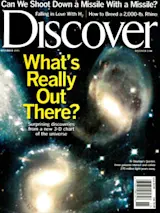The sky isn't falling, but it is fading. The first comprehensive atlas of light pollution reveals that 99 out of 100 people in the continental United States never see a truly dark night sky. As a result of widespread artificial lighting, more than two thirds of Americans never see the Milky Way, the cumulative glow of all the stars in our galaxy. Two fifths live in places where the sky is so heavily illuminated that their eyes never become adapted to night vision at all. And at near-urban observatories such as Mount Palomar, the artificial glow frustrates many sensitive studies.
According to Chris Elvidge of the National Oceanic and Atmospheric Administration and his colleagues, two thirds of the world's population experiences some amount of light pollution. Why do we create so much illumination? Lighting is cheap, says Elvidge, and most people don't consider light pollution a problem. But scientists estimate the United States could save $1 billion a year by switching to more efficient bulbs and downward-directed lighting.














